Is Loose-Fill Plastic Waste an Opportunity for Thermal Insulation in Cold and Humid Tropical Climates?
Abstract
1. Introduction
2. Materials and Methods
2.1. Analysis of the Plastic Wastes Used
2.1.1. Chemical Analyses
2.1.2. Loose-Fill Material Preparation and Preliminary Analysis
2.2. Experiment in Real Weather Conditions
2.2.1. Description of the Test Cells
2.2.2. Study Climates and Analysis Period
2.2.3. Thermal Comfort Analysis Method
3. Results and Discussion
3.1. FTIR Chemical Analyses
3.2. Particule Size Distribution
3.3. Experimentation in Real Environment
3.3.1. Impact of the LFPW on Surface Temperatures
- From 18 August 2020 to 10 September 2020: Corresponding to the end of the winter and the beginning of the winter inter-season (respectively, periods 3 and 4 in Figure 4);
- From 13 April 2021 to 8 July 2021: Corresponding to the summer inter-season until the middle of the winter season (respectively, periods 2 and 3 in Figure 4). As this second measurement phase is the longest (87 days), we isolate from this section the coldest week (from 20 to 28 June 2021). The entire period is analyzed in Section 3.3.5.
3.3.2. LFPW Performance on Two Typical Days
3.3.3. Study of the Thermal Gradient within the LFPW
3.3.4. Impact on Thermal Comfort
3.3.5. LFPW Performance over All Periods
4. Conclusions and Perspectives
Author Contributions
Funding
Institutional Review Board Statement
Informed Consent Statement
Data Availability Statement
Acknowledgments
Conflicts of Interest
References
- Kaza, S.; Yao, L.; Bhada-Tata, P.; Van Woerden, F. What a Waste 2.0: A Global Snapshot of Solid Waste Management to 2050; Technical Report; World Bank Group: Washington, DC, USA, 2018. [Google Scholar]
- Intini, F.; Kühtz, S. Recycling in buildings: An LCA case study of a thermal insulation panel made of polyester fiber, recycled from post-consumer PET bottles. Int. J. Life Cycle Assess. 2011, 16, 306–315. [Google Scholar] [CrossRef]
- Ingrao, C.; Lo Giudice, A.; Tricase, C.; Rana, R.; Mbohwa, C.; Siracusa, V. Recycled-PET fibre based panels for building thermal insulation: Environmental impact and improvement potential assessment for a greener production. Sci. Total Environ. 2014, 493, 914–929. [Google Scholar] [CrossRef]
- Silva, D.; Betioli, A.; Gleize, P.; Roman, H.; Gómez, L.; Ribeiro, J. Degradation of recycled PET fibers in Portland cement-based materials. Cem. Concr. Res. 2005, 35, 1741–1746. [Google Scholar] [CrossRef]
- Pelisser, F.; da S. Santos Neto, A.B.; Rovere, H.L.L.; de Andrade Pinto, R.C. Effect of the addition of synthetic fibers to concrete thin slabs on plastic shrinkage cracking. Constr. Build. Mater. 2010, 24, 2171–2176. [Google Scholar] [CrossRef]
- Bhogayata, A.C.; Arora, N.K. Impact strength, permeability and chemical resistance of concrete reinforced with metalized plastic waste fibers. Constr. Build. Mater. 2018, 161, 254–266. [Google Scholar] [CrossRef]
- Patnaik, A.; Mvubu, M.; Muniyasamy, S.; Botha, A.; Anandjiwala, R.D. Thermal and sound insulation materials from waste wool and recycled polyester fibers and their biodegradation studies. Energy Build. 2015, 92, 161–169. [Google Scholar] [CrossRef]
- Jackowski, M.; Małek, M. A multi-site study of a new cement composite brick with partial cement substitutes and waste materials. Case Stud. Constr. Mater. 2023, 18, e01992. [Google Scholar] [CrossRef]
- Małek, M.; Jackowski, M.; Łasica, W.; Kadela, M. Influence of polypropylene, glass and steel fiber on the thermal properties of concrete. Materials 2021, 14, 1888. [Google Scholar] [CrossRef] [PubMed]
- Rebeiz, K. Precast use of polymer concrete using unsaturated polyester resin based on recycled PET waste. Constr. Build. Mater. 1996, 10, 215–220. [Google Scholar] [CrossRef]
- Tawfik, M.E.; Eskander, S.B. Polymer Concrete from Marble Wastes and Recycled Poly(ethylene terephthalate). J. Elastomers Plast. 2006, 38, 65–79. [Google Scholar] [CrossRef]
- Rebeiz, K.; Craft, A. Plastic waste management in construction: Technological and institutional issues. Resour. Conserv. Recycl. 1995, 15, 245–257. [Google Scholar] [CrossRef]
- Bulut, H.A.; Şahin, R. A study on mechanical properties of polymer concrete containing electronic plastic waste. Compos. Struct. 2017, 178, 50–62. [Google Scholar] [CrossRef]
- Wijesekara, D.A.; Sargent, P.; Ennis, C.J.; Hughes, D. Prospects of using chars derived from mixed post waste plastic pyrolysis in civil engineering applications. J. Clean. Prod. 2021, 317, 128212. [Google Scholar] [CrossRef]
- Nyika, J.; Dinka, M. Recycling plastic waste materials for building and construction Materials: A minireview. Mater. Today Proc. 2022, 62, 3257–3262. [Google Scholar] [CrossRef]
- Maneeth Pd, P.K.K.; Shetty, S. Utilization of Waste Plastic in Manufacturing of Plastic-Soil Bricks. Int. J. Eng. Res. Technol. (IJERT) 2014, 3, 529–536. [Google Scholar]
- Siddique, R.; Khatib, J.; Kaur, I. Use of recycled plastic in concrete: A review. Waste Manag. 2008, 28, 1835–1852. [Google Scholar] [CrossRef]
- Almeshal, I.; Tayeh, B.A.; Alyousef, R.; Alabduljabbar, H.; Mustafa Mohamed, A.; Alaskar, A. Use of recycled plastic as fine aggregate in cementitious composites: A review. Constr. Build. Mater. 2020, 253, 119146. [Google Scholar] [CrossRef]
- Gu, L.; Ozbakkaloglu, T. Use of recycled plastics in concrete: A critical review. Waste Manag. 2016, 51, 19–42. [Google Scholar] [CrossRef]
- Saikia, N.; de Brito, J. Use of plastic waste as aggregate in cement mortar and concrete preparation: A review. Constr. Build. Mater. 2012, 34, 385–401. [Google Scholar] [CrossRef]
- Li, X.; Ling, T.C.; Hung Mo, K. Functions and impacts of plastic/rubber wastes as eco-friendly aggregate in concrete—A review. Constr. Build. Mater. 2020, 240, 117869. [Google Scholar] [CrossRef]
- Selvam, M.; Debbarma, S.; Singh, S.; Shi, X. Utilization of alternative aggregates for roller compacted concrete pavements—A state-of-the-art review. Constr. Build. Mater. 2022, 317, 125838. [Google Scholar] [CrossRef]
- Kazemi, M.; Faisal Kabir, S.; Fini, E.H. State of the art in recycling waste thermoplastics and thermosets and their applications in construction. Resour. Conserv. Recycl. 2021, 174, 105776. [Google Scholar] [CrossRef]
- Zhao, J.R.; Zheng, R.; Tang, J.; Sun, H.J.; Wang, J. A mini-review on building insulation materials from perspective of plastic pollution: Current issues and natural fibres as a possible solution. J. Hazard. Mater. 2022, 438, 129449. [Google Scholar] [CrossRef]
- Babaremu, K.O.; Okoya, S.A.; Hughes, E.; Tijani, B.; Teidi, D.; Akpan, A.; Igwe, J.; Karera, S.; Oyinlola, M.; Akinlabi, E.T. Sustainable plastic waste management in a circular economy. Heliyon 2022, 8, e09984. [Google Scholar] [CrossRef]
- Megri, A.C.; Achard, G.; Haghighat, F. Using plastic waste as thermal insulation for the slab-on-grade floor and basement of a building. Build. Environ. 1998, 33, 97–104. [Google Scholar] [CrossRef]
- Datsyuk, V.; Trotsenko, S.; Peikert, K.; Höflich, K.; Wedel, N.; Allar, C.; Sick, T.; Deinhart, V.; Reich, S.; Krcmar, W. Polystyrene nanofibers for nonwoven porous building insulation materials. Eng. Rep. 2019, 1, e12037. [Google Scholar] [CrossRef]
- Choi, J.; Yang, I.; Kim, S.S.; Cho, S.Y.; Lee, S. Upcycling Plastic Waste into High Value-Added Carbonaceous Materials. Macromol. Rapid Commun. 2022, 43, 210–467. [Google Scholar] [CrossRef] [PubMed]
- Abu-Thabit, N.Y.; Pérez-Rivero, C.; Uwaezuoke, O.J.; Ngwuluka, N.C. From waste to wealth: Upcycling of plastic and lignocellulosic wastes to PHAs. J. Chem. Technol. Biotechnol. 2021. [Google Scholar] [CrossRef]
- Lopez Hurtado, P.; Rouilly, A.; Vandenbossche, V.; Raynaud, C. A review on the properties of cellulose fibre insulation. Build. Environ. 2016, 96, 170–177. [Google Scholar] [CrossRef]
- Bénard, F.; Malet-Damour, B. Assessing potential of plastic waste management policies for territories sustainability: Case study of Reunion Island. World Dev. Sustain. 2022, 1, 100030. [Google Scholar] [CrossRef]
- Miranville, F.; Boyer, H.; Lauret, P.; Lucas, F. A combined approach for determining the thermal performance of radiant barriers under field conditions. Sol. Energy 2008, 82, 399–410. [Google Scholar] [CrossRef]
- Guichard, S.; Miranville, F.; Bigot, D.; Boyer, H. A thermal model for phase change materials in a building roof for a tropical and humid climate: Model description and elements of validation. Energy Build. 2014, 70, 71–80. [Google Scholar] [CrossRef]
- Djongyang, N.; Tchinda, R.; Njomo, D. Thermal comfort: A review paper. Renew. Sustain. Energy Rev. 2010, 14, 2626–2640. [Google Scholar] [CrossRef]
- Givoni, B. Comfort, climate analysis and building design guidelines. Energy Build. 1992, 18, 11–23. [Google Scholar] [CrossRef]
- Bellamy, L.J. The Infra-Red Spectra of Complex Molecules; Springer: Dordrecht, The Netherlands, 1975. [Google Scholar] [CrossRef]
- Krimm, S.; Liang, C.Y.; Sutherland, G.B.B.M. Infrared spectra of high polymers. V. Polyvinyl alcohol. J. Polym. Sci. 1956, 22, 227–247. [Google Scholar] [CrossRef]
- Coates, J. Interpretation of Infrared Spectra, A Practical Approach. In Encyclopedia of Analytical Chemistry; John Wiley & Sons, Inc.: Hoboken, NJ, USA, 2006. [Google Scholar] [CrossRef]
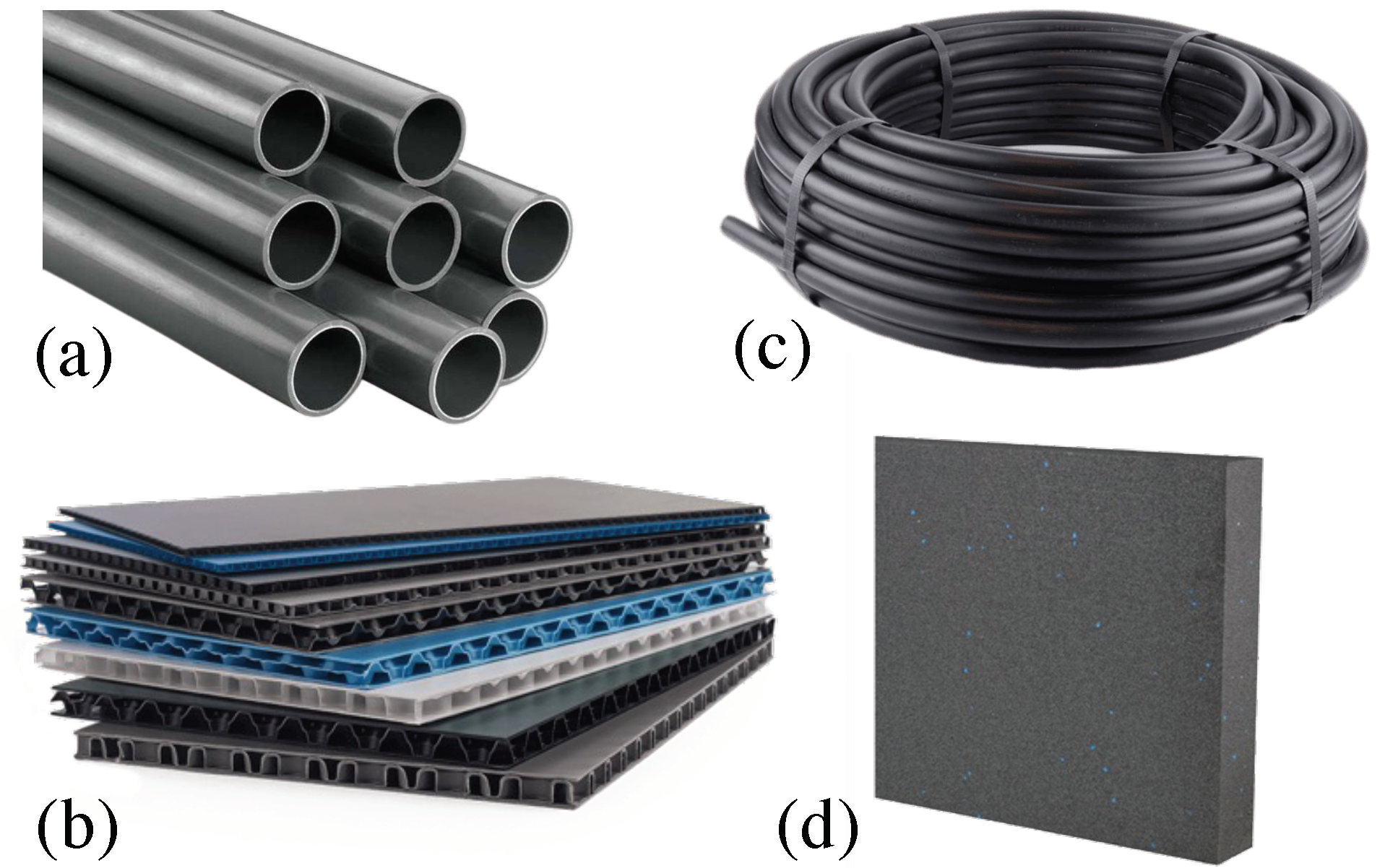
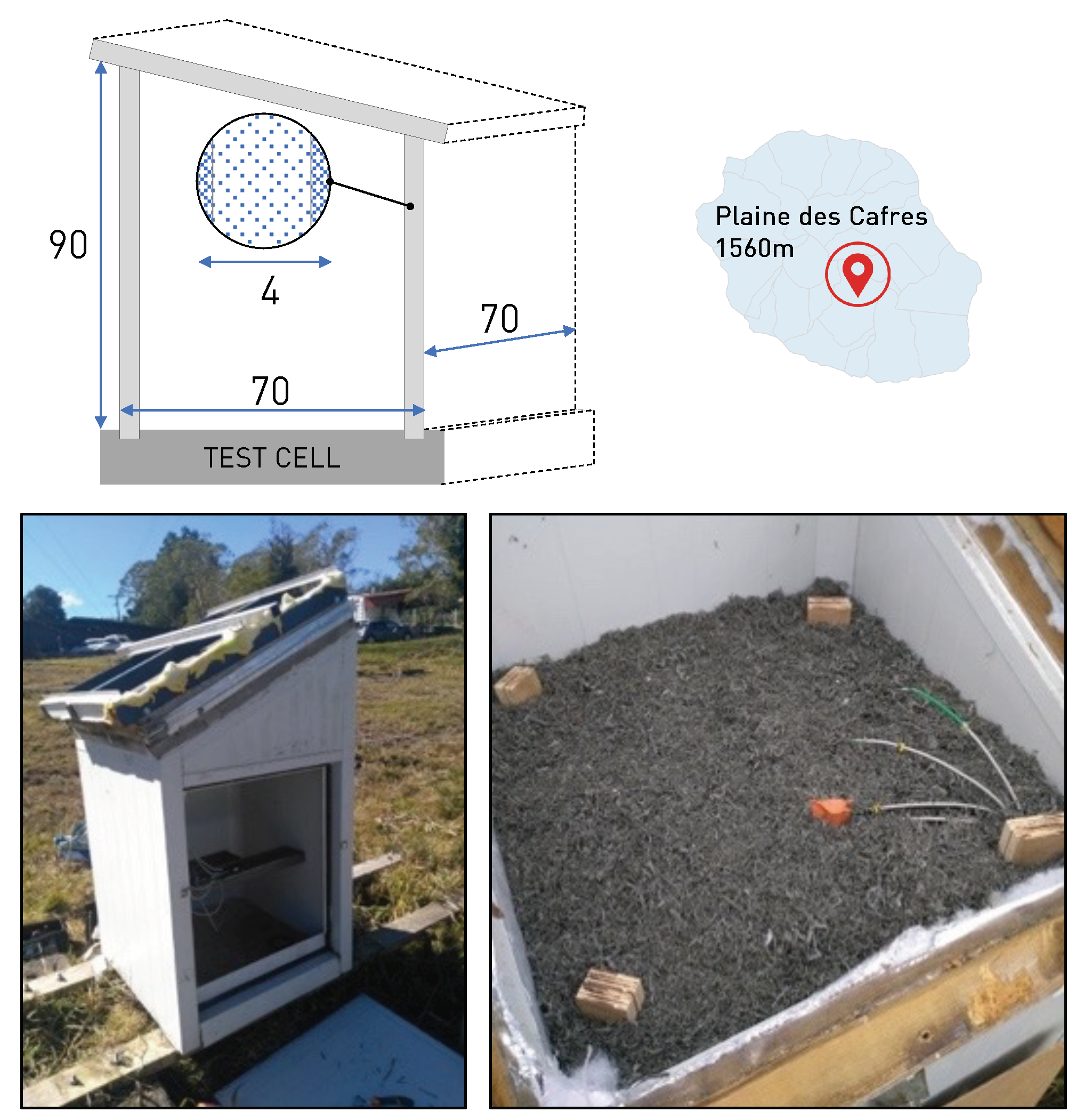


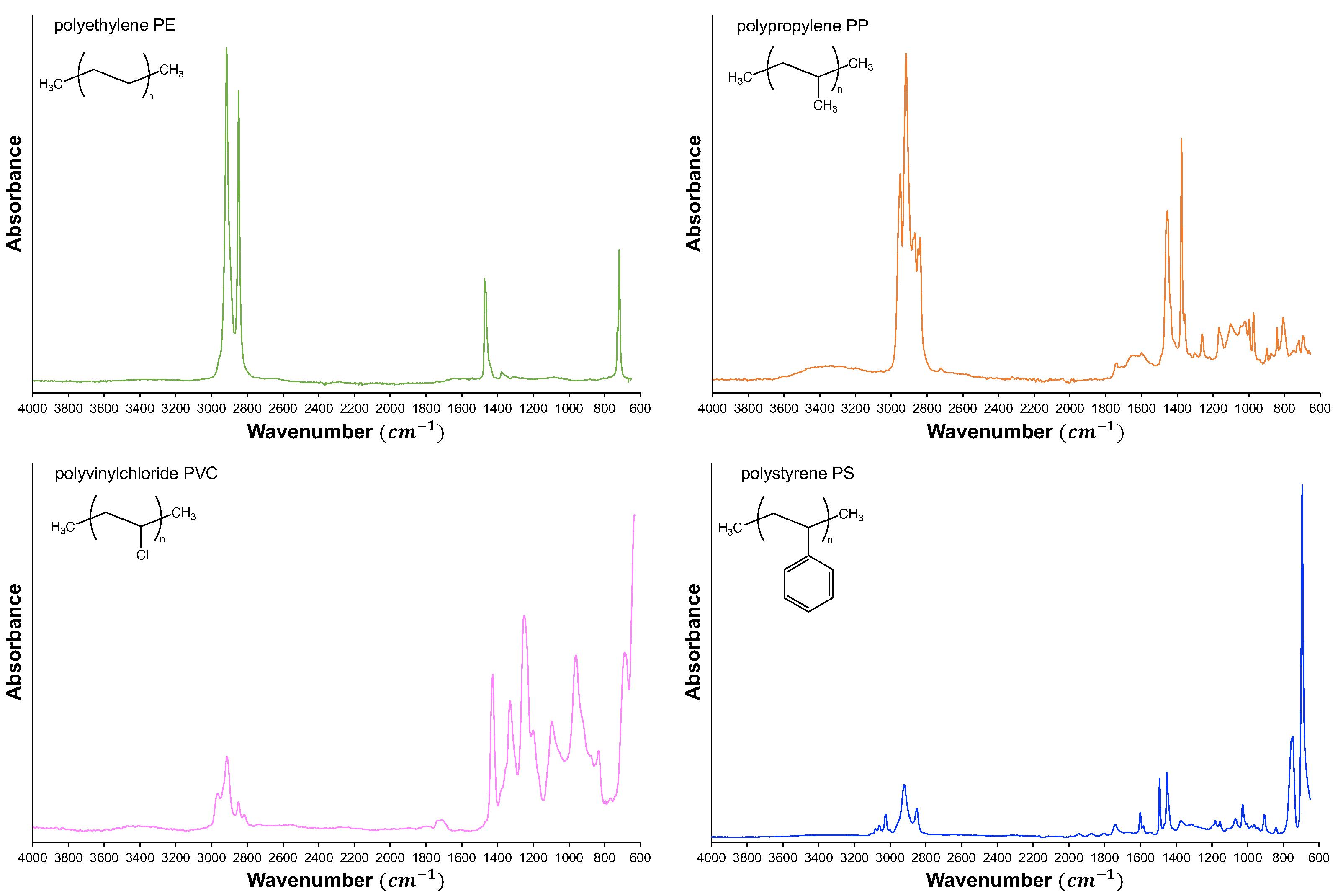


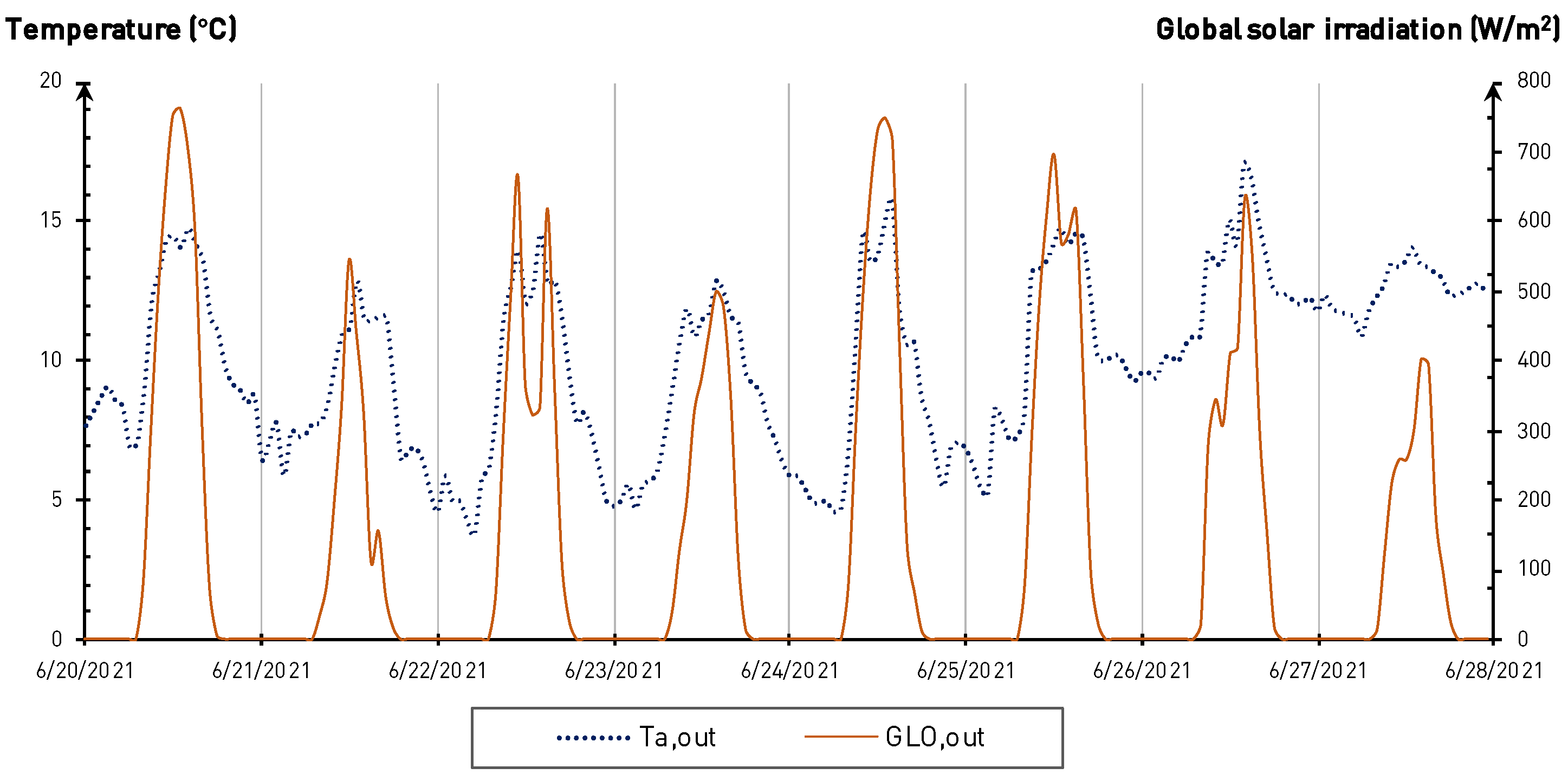

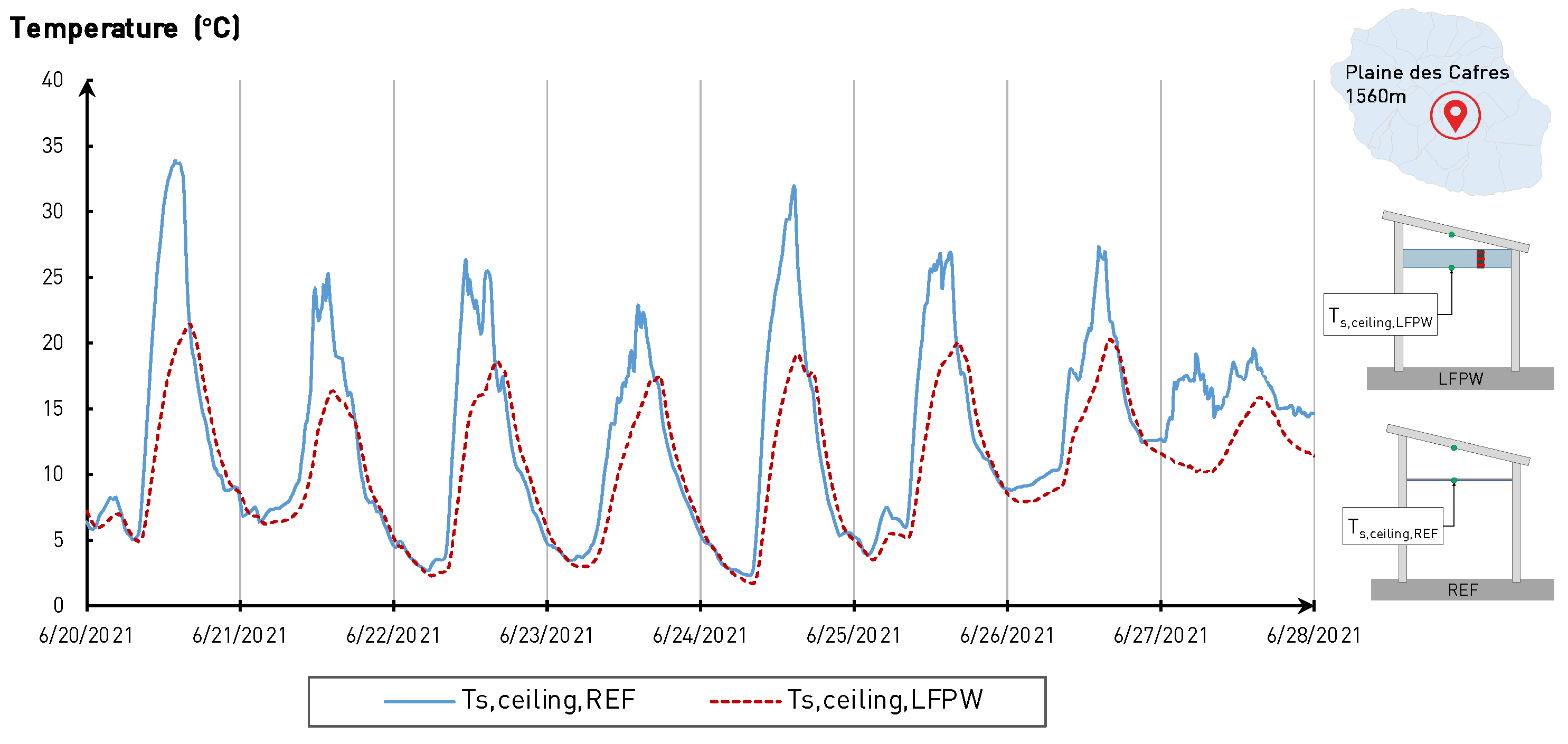




| Thermal Insulation Material | Thermal Conductivity [W/m.K] | Apparent Density [g/cm] |
|---|---|---|
| Loose fill Plastic Waste (LFPW) | 0.022–0.032 | 0.056 |
| Cellulose wadding in bulk | 0.035–0.041 | 0.023 |
| Rock wool | 0.030–0.040 | 0.016 |
| Polyurethane foam | 0.021–0.028 | 0.024 |
| Plastic | Main Characteristic Absorbance Bands |
|---|---|
| polyethylene (PE) | 2850–2915 cm: |
| 1425–1470 cm: | |
| 718–728 cm: | |
| polypropylene (PP) | 2838–2949 cm: |
| 1377–1460 cm: | |
| 718–815 cm: | |
| polyvinylchloride (PVC) | 2805–2950 cm: |
| 1325–1430 cm: | |
| 680–830 cm: | |
| 630 cm: | |
| polystyrene (PS) | 3002–3095 cm: |
| 2805–2950 cm: | |
| 1449–1451 cm: | |
| 1488 cm: | |
| 1025–1251 cm: | |
| 744 cm: | |
| 690–902 cm: |
| Periods | Climate Conditions | Givoni Bioclimatic Zones | REF (%) | LFPW (%) | Deviation (LFPW–REF) (%) |
|---|---|---|---|---|---|
| Period 1 From 9 October to 10 April | Summer | Zone 1: with no change | 19 | 19 | 0 |
| Zone 2: with airspeed at 0.5 m/s | 28 | 26 | −2 | ||
| Zone 3: with airspeed at 1 m/s | 32 | 30 | −2 | ||
| Periods 2 and 4 From 11 April to 31 May and From 1 September to 8 October | Summer inter-season considerations | Zone 1: with no change | 11 | 3 | −8 |
| Zone 2: with airspeed at 0.5 m/s | 19 | 14 | −5 | ||
| Zone 3: with airspeed at 1 m/s | 25 | 23 | −2 | ||
| Winter inter-season considerations | Zone 1: with no change | 13 | 3 | −10 | |
| Zone 2: with internal gains | 23 | 7 | −16 | ||
| Zone 3: with passive solar heating | 29 | 10 | −19 | ||
| Period 3 From 1 June to 31 August | Winter | Zone 1: with no change | 15 | 9 | −6 |
| Zone 2: with internal gains | 29 | 23 | −6 | ||
| Zone 3: with passive solar heating | 42 | 37 | −5 |
| Parameters | Periods | Designation | Average | Minimum | Maximum |
|---|---|---|---|---|---|
| Air temperature (C) | From 17 July 2020 to 10 July 2021 | 14.1 | 1.1 | 25.7 | |
| 16.7 | −2.1 | 38.9 | |||
| 16.1 | −1.4 | 34.0 | |||
| 0.7 | −4.3 | 19.7 | |||
| Average deviation | 1.2 | ||||
| Surface temperature (C) | From 18 August 2020 to 10 September 2020 and From 13 April 21 to 8 July 21 | 15.6 | 1.5 | 39.9 | |
| 13.1 | 1.3 | 27.3 | |||
| 2.5 | −6.1 | 22.2 | |||
| Average deviation | 3.2 | ||||
| Relative humidity (%) | From 17 July 2020 to 10 July 2021 | 87.2 | 17.0 | 100.0 | |
| 75.1 | 25.3 | 99.9 | |||
| 80.1 | 55.1 | 98.3 | |||
| −5.0 | −44.5 | 76.6 | |||
| Average deviation | 9.5 | ||||
Disclaimer/Publisher’s Note: The statements, opinions and data contained in all publications are solely those of the individual author(s) and contributor(s) and not of MDPI and/or the editor(s). MDPI and/or the editor(s) disclaim responsibility for any injury to people or property resulting from any ideas, methods, instructions or products referred to in the content. |
© 2023 by the authors. Licensee MDPI, Basel, Switzerland. This article is an open access article distributed under the terms and conditions of the Creative Commons Attribution (CC BY) license (https://creativecommons.org/licenses/by/4.0/).
Share and Cite
Malet-Damour, B.; Habas, J.-P.; Bigot, D. Is Loose-Fill Plastic Waste an Opportunity for Thermal Insulation in Cold and Humid Tropical Climates? Sustainability 2023, 15, 9483. https://doi.org/10.3390/su15129483
Malet-Damour B, Habas J-P, Bigot D. Is Loose-Fill Plastic Waste an Opportunity for Thermal Insulation in Cold and Humid Tropical Climates? Sustainability. 2023; 15(12):9483. https://doi.org/10.3390/su15129483
Chicago/Turabian StyleMalet-Damour, Bruno, Jean-Pierre Habas, and Dimitri Bigot. 2023. "Is Loose-Fill Plastic Waste an Opportunity for Thermal Insulation in Cold and Humid Tropical Climates?" Sustainability 15, no. 12: 9483. https://doi.org/10.3390/su15129483
APA StyleMalet-Damour, B., Habas, J.-P., & Bigot, D. (2023). Is Loose-Fill Plastic Waste an Opportunity for Thermal Insulation in Cold and Humid Tropical Climates? Sustainability, 15(12), 9483. https://doi.org/10.3390/su15129483






